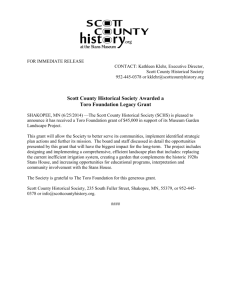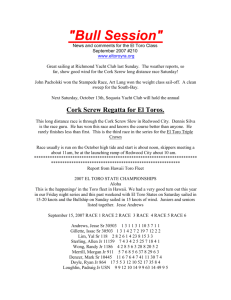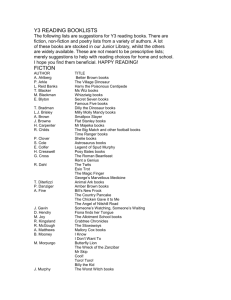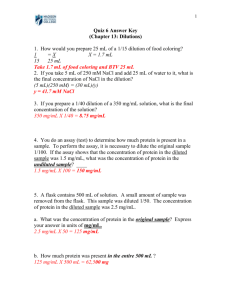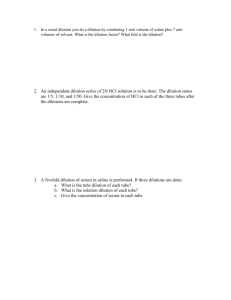Dilution at the TTAB
advertisement
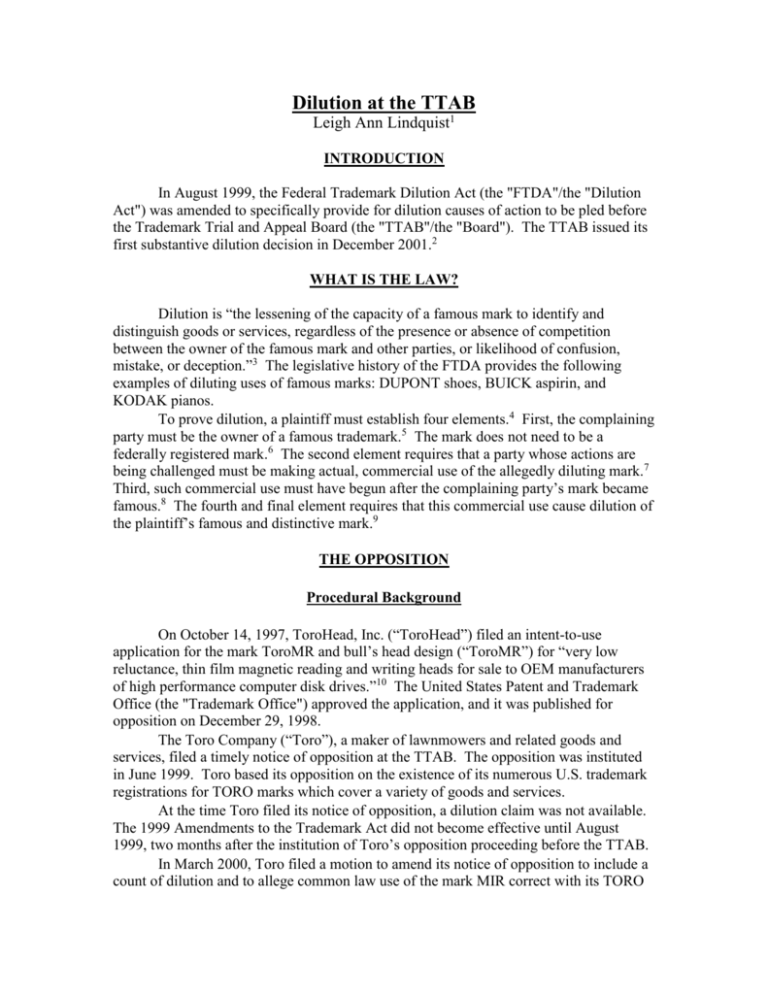
Dilution at the TTAB Leigh Ann Lindquist1 INTRODUCTION In August 1999, the Federal Trademark Dilution Act (the "FTDA"/the "Dilution Act") was amended to specifically provide for dilution causes of action to be pled before the Trademark Trial and Appeal Board (the "TTAB"/the "Board"). The TTAB issued its first substantive dilution decision in December 2001.2 WHAT IS THE LAW? Dilution is “the lessening of the capacity of a famous mark to identify and distinguish goods or services, regardless of the presence or absence of competition between the owner of the famous mark and other parties, or likelihood of confusion, mistake, or deception.”3 The legislative history of the FTDA provides the following examples of diluting uses of famous marks: DUPONT shoes, BUICK aspirin, and KODAK pianos. To prove dilution, a plaintiff must establish four elements.4 First, the complaining party must be the owner of a famous trademark.5 The mark does not need to be a federally registered mark.6 The second element requires that a party whose actions are being challenged must be making actual, commercial use of the allegedly diluting mark.7 Third, such commercial use must have begun after the complaining party’s mark became famous.8 The fourth and final element requires that this commercial use cause dilution of the plaintiff’s famous and distinctive mark.9 THE OPPOSITION Procedural Background On October 14, 1997, ToroHead, Inc. (“ToroHead”) filed an intent-to-use application for the mark ToroMR and bull’s head design (“ToroMR”) for “very low reluctance, thin film magnetic reading and writing heads for sale to OEM manufacturers of high performance computer disk drives.”10 The United States Patent and Trademark Office (the "Trademark Office") approved the application, and it was published for opposition on December 29, 1998. The Toro Company (“Toro”), a maker of lawnmowers and related goods and services, filed a timely notice of opposition at the TTAB. The opposition was instituted in June 1999. Toro based its opposition on the existence of its numerous U.S. trademark registrations for TORO marks which cover a variety of goods and services. At the time Toro filed its notice of opposition, a dilution claim was not available. The 1999 Amendments to the Trademark Act did not become effective until August 1999, two months after the institution of Toro’s opposition proceeding before the TTAB. In March 2000, Toro filed a motion to amend its notice of opposition to include a count of dilution and to allege common law use of the mark MIR correct with its TORO registered mark. ToroHead did not oppose the motion to amend, and the TTAB deferred ruling on the motion until final hearing, at which time it granted Toro’s motion. Toro’s Dilution Allegation In its amended notice of opposition, Toro alleged that its TORO mark was famous and had become famous prior to ToroHead’s first use of its mark, ToroMR, and design. Toro further claimed that use of ToroHead’s mark was likely to dilute the distinctive nature of Toro’s famous TORO mark by blurring.11 Toro asserted that its TORO mark had become famous due to extensive sales, advertising and promotion, and that consumers recognize its TORO marks “as indicating the leading producer of landscape irrigation, fertigation and beautification systems.”12 TTAB Application of the Dilution Act Because the Toro decision presented the first opportunity to apply the 1999 Amendments to the Lanham Act, the TTAB had to address a number of issues which would be unique to proceedings before the TTAB. How Does The Requirement of “Use” Apply In An Opposition Against An Intent to Use Application? The Dilution Act requires that a defendant (in Toro, the Applicant) be making actual commercial use of the mark and that such use begin after a plaintiff’s (here Opposer's) mark became famous. In the Toro case, the application at issue was based on ToroHead’s intent to use its mark in commerce. There was no actual use of the ToroMR mark. Thus, the plain language of the Dilution Act would appear to limit the application of a dilution allegation to marks which were the subject of applications based on use and marks which were the subject of registrations. The TTAB looked to the legislative history to interpret this language and found that Congress intended for dilution claims to be brought before the Board so that it could decide dilution issues in a “more timely, economical, and expeditious” fashion than a federal district court.13 If one were to read the Dilution Act in a vacuum and determine that actual use was required before dilution could be alleged, most dilution claims would be brought as cancellation proceedings before the TTAB or in federal district court. Since the TTAB does not have the authority to issue injunctions, famous mark holders would only want to file an action for dilution in federal district court. The Board determined that such an interpretation would defeat the purpose of the 1999 Amendments to the Lanham Act and not further the stated purpose of judicial efficiency.14 At What Point Does Opposer’s Mark Have to be Famous? The third element a court considers in a dilution analysis is whether the allegedly diluting use began after the plaintiff’s/opposer’s mark became famous. In a TTAB proceeding involving an intent to use application, the question becomes “by what date must an owner of an allegedly famous mark prove that its mark has become famous?”15 Based on the special provisions accorded intent to use applications filed with the Trademark Office,16 the TTAB determined that an opposer, or petitioner, need only establish the fame of its mark prior to the filing date of the intent to use application. Which Marks are Famous Marks? Given the extraordinary17 remedy a finding of dilution grants, only certain marks of such a famous nature are even capable of being diluting. In recognition of this fact, the TTAB noted at the outset of its dilution discussion in Toro that, “unlike in likelihood of confusion cases, we will not resolve doubts in favor of the party claiming dilution.”18 The FTDA details a non-exclusive list of factors to determine whether or not a mark has achieved fame for purposes of dilution.19 These factors include: a mark’s inherent or acquired distinctiveness; the duration and extent of use of the mark; the duration and extent of the mark’s promotion; the mark’s geographical trading area; the mark’s channels of trade; recognition of the mark; the existence of similar third party marks; and when the mark was registered.20 Even though it would seem the courts could reach a consensus on what type of mark is famous given that the FTDA provides specific guidance, the courts have not been uniform in their assessment of fame. The major divergence among the circuit courts involves whether or not “distinctiveness” and “fame” are synonyms or are separate and distinct concepts which require individual consideration.21 The split, in essence, is how famous must a mark be for a plaintiff to be granted the extraordinary remedy of dilution? The Distinctiveness of a Mark In Toro, the TTAB determined that “distinctiveness” and “fame” are separate concepts, each deserving consideration for dilution purposes.22 “Distinctiveness” has an accepted definition in trademark law for purposes of determining the registrability of a mark.23 If a mark is not distinctive, it does not function as a trademark and is ineligible for registration on the Principal Register. Marks, however, may acquire distinctiveness over time and, thereby, become registrable. For purposes of dilution, however, only those marks which are so distinctive “that the public would associate the term with the owner of the famous mark even when it encounters the term apart from the owner’s goods or services, i.e., devoid of its trademark context” are truly famous.24 According to the TTAB, a mark may be famous, but there may also be third party uses of the mark which would suggest that the mark is not so distinctive that a dilution remedy is in order.25 In addition, a mark may have a known meaning, apart from trademark significance, which serves to weaken that mark and make it less distinctive. The TTAB took the position in Toro that the TORO mark was not so distinctive that it could be considered famous. “Toro” is Spanish for bull, and many Americans speak Spanish and would recognize the term “toro” as having significance apart from its trademark significance identifying Toro. In fact, Toro failed to present any evidence to the TTAB which showed “consumer recognition of the mark as pointing uniquely to opposer.”26 Is TORO Famous? After considering the evidence submitted by Toro, the TTAB concluded that the TORO mark was not famous and that, therefore, dilution had not been established.27 In making this determination, the Board noted that Toro had submitted evidence that its mark had been in use since the 1950s, other parties did not use the mark TORO on “machinery, equipment, or computer-related products,” considerable sums of money had been spent on advertising, and there were substantial sales of its products. However, the evidence submitted was limited to a specific trading field, specifically, professional groundskeeping. There was no evidence that members of the general public knew the mark TORO and associated the mark with Toro and its goods and services. Nothing established “that when the public encounters the mark on unrelated goods, this use would immediately call to mind opposer’s mark.”28 Moreover, Toro did not submit any evidence which would show that purchasers of ToroHead’s computer related goods would be potential purchasers of Toro’s machinery and equipment or even familiar with Toro. WHAT EVIDENCE IS REQUIRED TO ESTABLISH FAME AT THE TTAB? Recognizing that its decision was unusual given that Toro used its mark continuously for a long period of time on a variety of products, spent substantial sums on advertising, and generated large numbers of sales, the TTAB expanded its discussion to further explain its position. According to the TTAB: [A]n owner of a famous mark is attempting to demonstrate that the English language had changed … the mark’s owner must demonstrate that the common or proper noun uses of the term and the third-party uses of the mark are now eclipsed by the owner’s use of the mark …To achieve this level of fame and distinctiveness, the party must demonstrate that the mark has become the principal meaning of the word.29 The TTAB stated that there are at least three means to prove a truly famous mark. First, the other party may recognize the fame of the plaintiff’s mark.31 Second, there may be evidence of intense media attention of the mark such as coverage in national magazine publications.32 Last, a survey of consumers may illustrate that a particular mark has become the recognized meaning of the word.33 These three pieces of evidence are provided by the Board in descending order of preference for the party alleging dilution. 30 CONCLUSION The TTAB, in its Toro decision, has provided an insightful analysis and grounded reasoning for its position. Its discussion of the fame factor offers a guide for proving dilution in future actions. In addition, there is no question that dilution causes of action before the Board will be difficult to prove and dilution should only be pled in those cases where the fame of a particular mark is fairly clear cut. Nevertheless, the TTAB has not pigeon-holed the Trademark Office into a set dilution framework. For example, the Board did not decide the issue of niche market fame which is accepted by various circuit courts.34 The Board has left room to make decisions based on the specific facts of a case. In short, the Toro decision is useful to practitioners and provides guidance as to what type of dilution claims should be made in inter parties proceedings. ENDNOTES: 1. Trademark Associate in the Washington, D.C. office of SUGHRUE MION, PLLC. 2. The Toro Co. v. ToroHead, Inc., 61 U.S.P.Q.2d 1164 (TTAB 2001). 3. 15 U.S.C. §1127. 4. Id. 5. Id. 6. 141 Cong. Rec. H14318 (daily ed. Dec. 12, 1995) (Statement of Rep. Schroeder). 7. Id. 8. Id. 9. Id. 10. 61 U.S.P.Q.2d at 1166. 11. Blurring arises when the unique and distinctive nature of a senior user’s mark is weakened because consumers will see the plaintiff’s mark applied to or used in connection with a variety of goods and services marketed by entities unrelated to plaintiff. An early well-known dilution by blurring case is Polaroid Corp. v. Polaraid, Inc., 319 F.2d 830 (7th Cir. 1963) which involved the mark POLAROID for optical devices, cameras, film, etc. The Seventh Circuit found that the mark POLARAID for installation of refrigeration and heating systems diluted the mark POLAROID which the court held was strong and entitled to protection from dilution. In a second dilution by blurring case, the U.S. District Court for the Southern District of Georgia found that the mark LADIES’ MASTERS for golf tournaments infringed and diluted the mark MASTERS for golf tournaments. Augusta Nat’l, Inc. v. Northwestern Mut. Life Ins. Co., 193 U.S.P.Q. 210 (S.D. Ga. 1976). 12. 61 U.S.P.Q.2d at 1173. 13. Id. at 1174. 14. Id. 15. Id. 16. Intent to use applications are provided a “constructive use” date by the Lanham Act which means that the filing date of the application constitutes the constructive use date for purposes of priority. See 15 U.S.C. §1057(c). 17. 61 U.S.P.Q.2d at 1173-74 (citing Advantage Rent-A-Car, Inc. v Enterprise Rent-A-Car Co., 238 F.3d 378 (5th Cir. 2001)). “[W]e simply cannot believe that, as a general proposition, Congress could have intended, without making its intention to do so perfectly clear, to create property rights in gross, unlimited in time (via injunction), even in ‘famous’ trademarks.” Ringling Bros.-Barnum & Bailey Combined Shows v. Utah Division of Travel Development, 170 F.3d 449 (4th Cir. 1999). See also Nabisco, Inc. v. BF Brands, Inc., 191 F.3d 208, 224 n.6 (2d Cir. 1999) (“We agree that the dilution statutes do not prohibit all use of a distinctive mark that the owners prefer not be made … [W]e agree with the Fourth Circuit that the dilution statutes do not create a ‘property right in gross’”); I.P. Lund Trading ApS v. Kohler Co., 163 F.3d 27 (1st Cir. 1998) (“[T]he standard for fame and distinctiveness required to obtain anti-dilution protection is more rigorous than that required to seek infringement protection”). 18. 61 U.S.P.Q.2d at 1174. 19. 15 U.S.C. §1125(c)(1). 20. Id. 21. Some courts hold that dilution requires satisfaction of four elements, as noted above. Eli Lilly & Co. v. Natural Answers, Inc., 233 F.3d 456 (7th Cir. 2000); Times Mirror Magazines, Inc. v. Las Vegas Sports News, L.L.C., 212 F.2d 157 (3d Cir. 2000); Ringling Bros.-Barnum & Bailey Combined Shows, Inc. v. Utah Division of Travel Development, 170 F.3d 449 (4th Cir. 1999); Panavision Int’l, L.P. v. Toeppen, 141 F.3d 1316, 1324 (9th Cir. 1998). The Second Circuit, however, has taken the position that there are five factors required to prove federal trademark dilution. Under the Second Circuit’s test, the additional factor requires that the plaintiff’s mark be distinctive. Nabisco, Inc. v. PF Brands, Inc., 191 F.3d 208 (2d Cir. 1999). This is in addition to the requirement that the mark be famous. The Sixth Circuit has joined the Second Circuit’s interpretation. See V Secret Catalogue, Inc. v. Moseley, 259 F.3d 464 (6th Cir. 2001). 22. 61 U.S.P.Q.2d at 1176-78. 23. The term “distinctive” has a clear and defined meaning in trademark law. In order for a term, symbol, design, color, slogan, etc. to function as a trademark, that particular term must be distinctive. 15 U.S.C. §1052(e) (“[N]othing herein shall prevent the registration of a mark used by the applicant which has become distinctive of the applicant’s goods in commerce.”). It may be distinctive at its creation or it may become distinctive over time. If a term is not distinctive, it simply does not function as a trademark. 24. Id. at 1177. 25. Id. 26. Id. at 1178. 27. Id. at 1179-81. 28. Id. at 1179. 29. Id. at 1180. 30. Id. at 1181. 31. Id. 32. Id. 33. Id. 34. Niche fame appears in cases where the plaintiff and defendant are operating in the same market segment. In these instances, some courts have held that a plaintiff need not prove fame in the broad, general market; the plaintiff need only establish its fame in the market in which both parties compete, i.e., in the parties’ “niche.” Advantage Rent-A-Car, Inc. v. Versus Enterprise Rent-A-Car, Co., 238 F.3d 378, 380-81 (5th Cir. 2001); Times Mirror Magazines, Inc. v. Las Vegas Sports News, L.L.C., 212 F.2d 157, 164-65 (3d Cir. 2000); Syndicate Sales, Inc. v. Hampshire Paper Corp., 192 F.3d 633, 640 (7th Cir. 1999). Not all of the courts accept the concept of niche fame with some courts taking the position that the general public is the relevant market for a fame determination. I.P. Lund Trading v. Kohler Co., 163 F.3d 27 (1st Cir. 1998) (“National renown is an important factor in determining whether a mark qualifies as famous under the FTDA.”); Michael Caruso & Co., Inc. v. Estefan Enterprises, Inc., 994 F. Supp. 1454 (S.D. Fla. 1998); King of the Mountain Sports, Inc. v. Chrysler Corp., 968 F. Supp. 558 (D. Colo. 1997).
